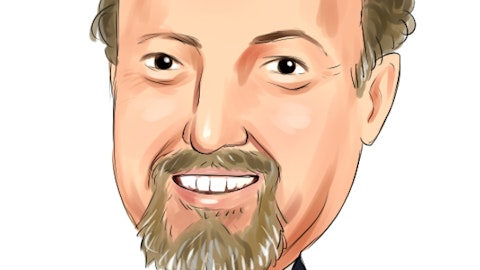Our credit strategy is interval funds and our non-traded credit BDC, BDEAT have a combined $1 billion plus of AUM. We received a really important placement for BDEAT as a National Wirehouse, so we think that will be a strong accelerant for organic growth. And then finally, that planned acquisition with GIP is going to really extend our capabilities. We think the business can be a much stronger platform for capital formation of scale and build on this philosophy we have in illiquid alternatives. We also think there’s a great opportunity to bring GIP’s capabilities to private wealth globally, retail retirement platforms in the U.K. and Europe with the LTIP and LTAP structures. And obviously, we’ll keep you updated on our progress.
Laurence Fink : I would just add that the feedback we’re having from clients, including a dinner I had with a major energy company last night. The opportunity we have for driving more unique proprietary origination is going to be driving accelerated growth for us in the private markets, especially in infrastructure. I do believe the combinations of our two organization is going to open up so many more avenues. Avenues with companies but also avenues with countries. And that being said, look, we’re always in the market and are looking for different opportunities and we’re not slowing down, looking at different opportunities. We’re not here to suggest we’re doing anything that is forthcoming because the number one through five things to do is to close GIP. But the doors are knocking at BlackRock to see if there’s other opportunities we want to pursue. And if it makes sense one day, we will continue to be open minded to pursue more private market opportunities.
Operator: We’ll go next to Dan Fannon with Jefferies.
Daniel Fannon : Martin for your comments on improving trends throughout the quarter for flows, can you put in context what that means for maybe exit fee rate? And also on this pipeline of activity that’s building, can you talk about the mix of fees and products more specifically and how that might inform your base fee outlook going forward?
Martin Small : As I mentioned, we see good base momentum. At the end of Q4, we were running at higher than target. At the end of this quarter, we’re at target. And as I mentioned, when we look at the trends over months, not days, we feel like we’re half or halfway plus to our target growth. So we’ve got good base fee momentum. First quarter base fees, excluding securities lending were $3.6 billion, which is up 9% year-on-year, which is largely due to the impact of market movements on AUM and organic growth. And if — the Q2 entry fee rate ex-fee lending is pretty much flat compared to the Q1 fee rate on a day count equivalent basis. But overall, I think as we see good flows into active with the $15 billion we’ve had, as I mentioned, retail flows of $7 billion coming in.
We see good fee rate trends, which we think are about — mostly about mix. We focus really on driving organic base fee growth in the most efficient way possible, focusing on the clients, focusing on the investments they want to make. We don’t focus on a specific fee rate or product. We focus on the clients and the fee rate is more of an output. But the trends in terms of where we’re raising assets on the fee rates we think are good. But as I mentioned, Q2 fee rate — Q2 entry fee rate excess funding is flat compared to the Q1 fee rate on the same day count.
Operator: We’ll go next to Bill Katz with TD Cowen.
William Katz : Appreciate the update. Maybe a different vein. Your performance fees continue to run pretty high. And just sort of wondering, are we reaching a new level of normalized performance fees? And how might that translate into sort of the comp ratio as we look ahead, particularly as you continue to migrate to a bigger pool of private markets post-GIP?
Martin Small : So on the performance fees of $204 million in the quarter, obviously, they’re up about 4x year-on-year. If you could put yourself in a time machine and think back to that first quarter in ’23, it was a really difficult market. We had SVB, we had some volume in the rate markets, et cetera. So I think it was a tough time. This quarter, we’ve really seen good performance coming through on our teams, which has been very, very strong and I think reflected in those performance fees. Rough just is about half of that performance fee is coming from kind of our private equity funds and private equity programs where we had some very successful realizations that Larry talked about last year, which was created in some of the distributions associated with that.
And the other half is more in illiquid hedge funds in our strategic equity hedge funds and some of our systematic strategies as well. Ultimately, our goal is to deliver long-term performance with clients and where we see performance fee revenues picking up, obviously, there’s healthy alignment there and more supportive markets and stronger markets and strong performance, we’d expect a lot of that leverage to drop to a lower comp to revenue ratio. But ultimately, talent is one of our key investments and we’d expect it to be on a go-forward basis.
Operator: We’ll go next to Brian Bedell with Deutsche Bank.
Brian Bedell : Maybe just to focus on the multi-asset category and a couple of areas within that. I think Martin, you were talking about obviously the build of the organic growth pipeline and also in conjunction with Larry, with your comments about the conversation pipeline. Can you talk about two areas, in particular, as that developed throughout the year. That would be OCIO deals and then also, as we start up LifePath Paycheck, how you anticipate that contributing to organic growth, I guess, as the year unfolds, obviously very early, but even over the next couple of years?





